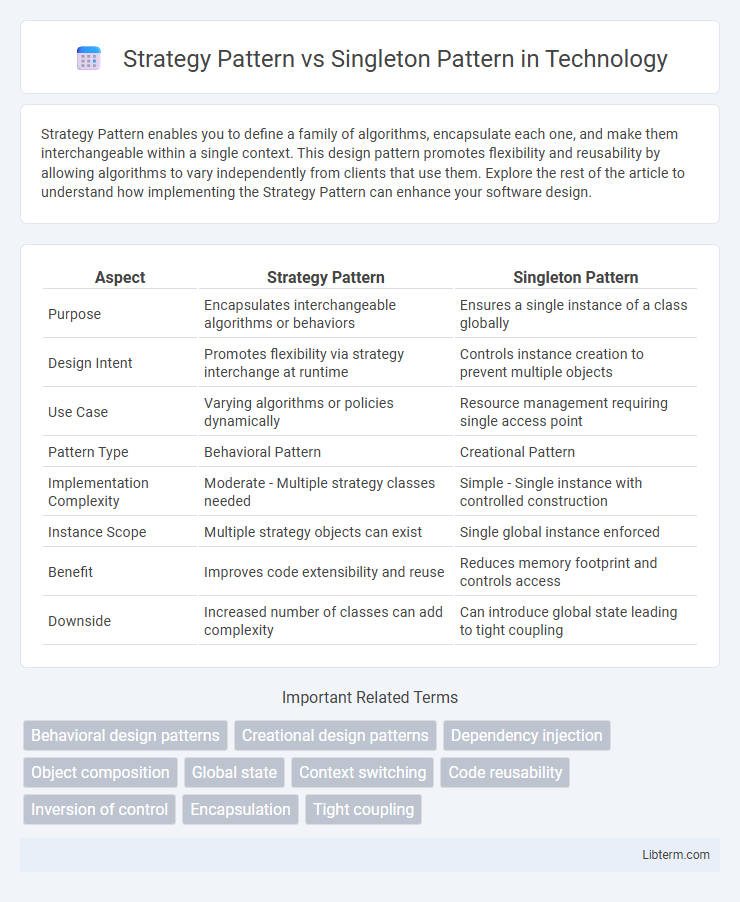Strategy Pattern enables you to define a family of algorithms, encapsulate each one, and make them interchangeable within a single context. This design pattern promotes flexibility and reusability by allowing algorithms to vary independently from clients that use them. Explore the rest of the article to understand how implementing the Strategy Pattern can enhance your software design.
Table of Comparison
| Aspect | Strategy Pattern | Singleton Pattern |
|---|---|---|
| Purpose | Encapsulates interchangeable algorithms or behaviors | Ensures a single instance of a class globally |
| Design Intent | Promotes flexibility via strategy interchange at runtime | Controls instance creation to prevent multiple objects |
| Use Case | Varying algorithms or policies dynamically | Resource management requiring single access point |
| Pattern Type | Behavioral Pattern | Creational Pattern |
| Implementation Complexity | Moderate - Multiple strategy classes needed | Simple - Single instance with controlled construction |
| Instance Scope | Multiple strategy objects can exist | Single global instance enforced |
| Benefit | Improves code extensibility and reuse | Reduces memory footprint and controls access |
| Downside | Increased number of classes can add complexity | Can introduce global state leading to tight coupling |
Introduction to Design Patterns
Design patterns provide standardized solutions to common software design problems, enhancing code maintainability and flexibility. The Strategy Pattern enables selecting algorithms at runtime by encapsulating them within interchangeable classes, promoting open/closed principle adherence. In contrast, the Singleton Pattern ensures a class has only one instance globally, controlling access and maintaining consistent state throughout an application.
Overview of the Strategy Pattern
The Strategy Pattern is a behavioral design pattern that enables selecting an algorithm's behavior at runtime by defining a family of interchangeable algorithms encapsulated in separate classes. It promotes flexibility and reusability by allowing the client to choose or change the algorithm dynamically without modifying the context. Unlike the Singleton Pattern, which restricts a class to a single instance, the Strategy Pattern focuses on varying algorithms independently from the clients that use them.
Overview of the Singleton Pattern
The Singleton Pattern ensures a class has only one instance while providing a global access point to that instance, making it ideal for managing shared resources like configurations or logging. This design pattern restricts object creation by maintaining a private static variable that holds the sole instance and a public static method to retrieve it. Proper implementation of the Singleton Pattern involves lazy initialization and thread safety to optimize resource usage and prevent concurrency issues in multi-threaded environments.
Key Differences Between Strategy and Singleton Patterns
The Strategy Pattern enables selecting an algorithm's behavior at runtime by defining a family of interchangeable algorithms, fostering flexibility and extensibility in code design. In contrast, the Singleton Pattern ensures a class has only one instance, providing a global point of access and controlling resource usage. The key difference lies in their purpose: Strategy focuses on algorithm variability, while Singleton centers on instance control and global accessibility.
Use Cases for Strategy Pattern
The Strategy Pattern is primarily used to enable interchangeable algorithms within a class, allowing dynamic selection of behavior at runtime without altering the client code. It is highly effective in scenarios requiring multiple variations of an algorithm, such as sorting, payment processing, or validation rules, where flexibility and extensibility are crucial. Unlike the Singleton Pattern, which restricts a class to a single instance, the Strategy Pattern fosters modular design by encapsulating distinct strategies separately, promoting maintainability and scalability.
Use Cases for Singleton Pattern
The Singleton Pattern is primarily used to ensure a class has only one instance while providing a global access point, which is ideal for managing shared resources like database connections, configuration settings, or logging services. It is especially valuable in scenarios requiring centralized control and consistent state across an application, such as caching mechanisms or thread pools. Unlike the Strategy Pattern, which promotes interchangeable algorithms, Singleton guarantees a single instance, making it well-suited for resource management and coordination tasks.
Benefits of Applying the Strategy Pattern
The Strategy Pattern enhances flexibility by allowing algorithms to be selected and switched dynamically at runtime without modifying the client code, promoting open/closed principle adherence. It enables easier maintenance and testing since each strategy encapsulates a distinct behavior, improving code readability and reducing complexity. This pattern supports scalability by facilitating the addition of new algorithms independently, avoiding bloated class hierarchies common in conditional logic implementations.
Benefits of Implementing the Singleton Pattern
The Singleton Pattern ensures a class has only one instance while providing a global access point, which simplifies resource management and reduces memory overhead. It enhances control over shared resources, such as database connections or configuration settings, preventing inconsistent states and promoting thread safety. Implementing the Singleton Pattern improves application performance by avoiding redundant object creation and facilitating centralized management.
Practical Examples in Code
The Strategy Pattern enables selecting an algorithm's behavior at runtime by encapsulating interchangeable methods, such as implementing different sorting algorithms within a common interface to switch based on data size or type. The Singleton Pattern ensures a single instance of a class throughout the application, often used for managing shared resources like database connections or logging services. Practical code examples show Strategy Pattern in game AI for dynamic decision-making, whereas Singleton Pattern controls global configurations or caching mechanisms efficiently.
Choosing the Right Pattern for Your Project
Choosing the right design pattern depends on the problem you're solving: the Strategy Pattern suits projects requiring dynamic algorithm selection by encapsulating interchangeable behaviors, while the Singleton Pattern ensures a single, globally accessible instance, ideal for managing shared resources like configurations or logging. Consider using the Strategy Pattern when you need flexibility and extensibility in behavior without modifying client code, whereas the Singleton Pattern is best when resource control and consistency are critical, avoiding multiple instances. Analyzing project requirements, such as the need for multiple strategies versus controlled instance creation, helps determine the most effective pattern for maintainability and scalability.
Strategy Pattern Infographic

 libterm.com
libterm.com